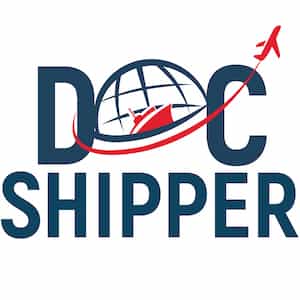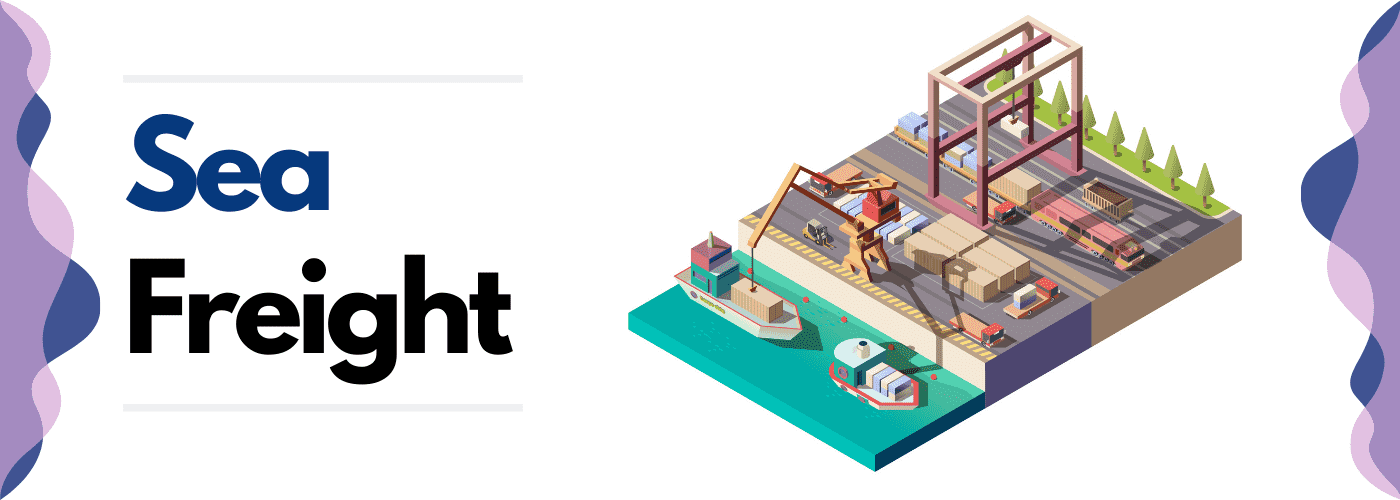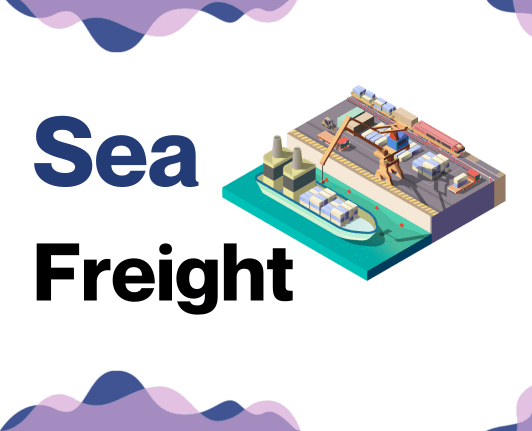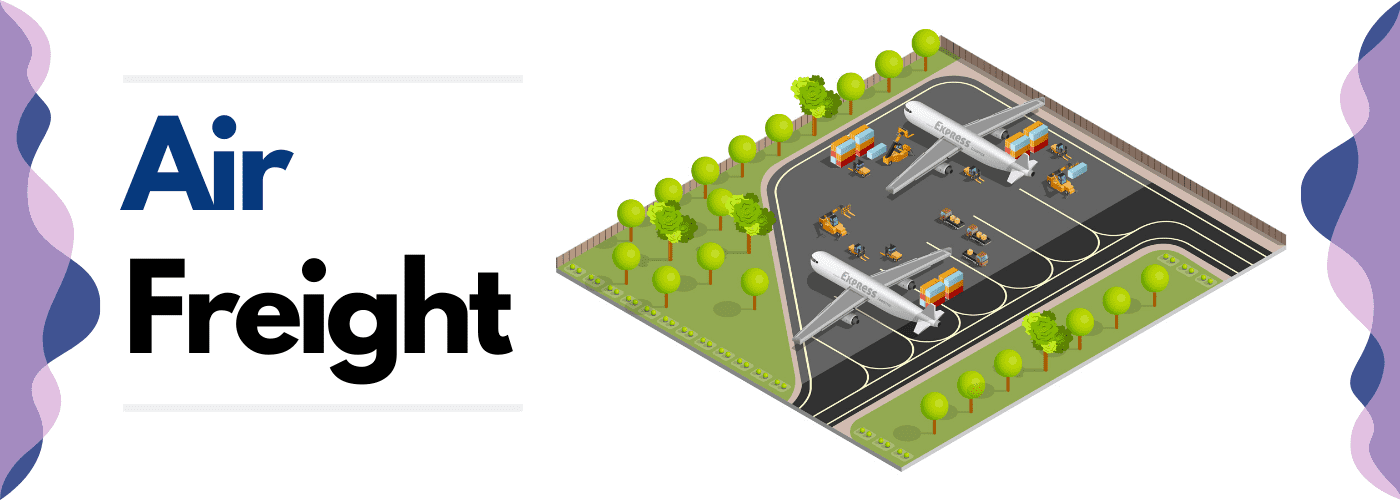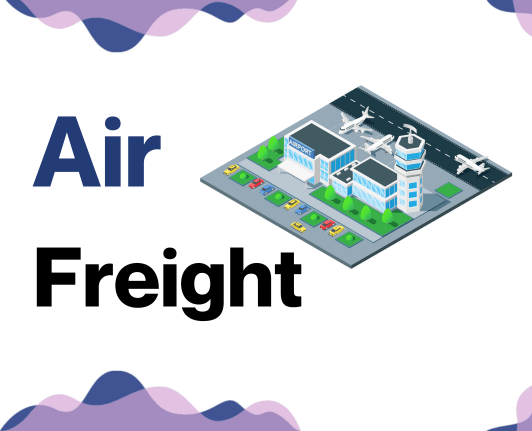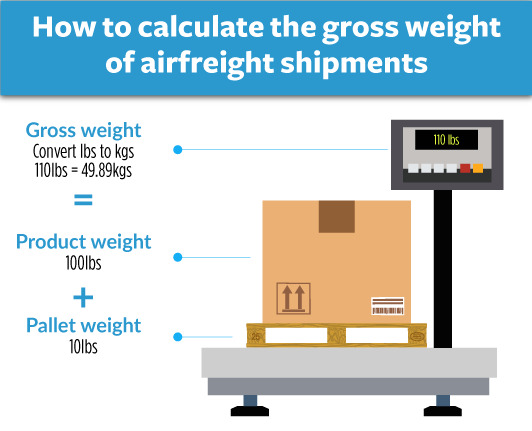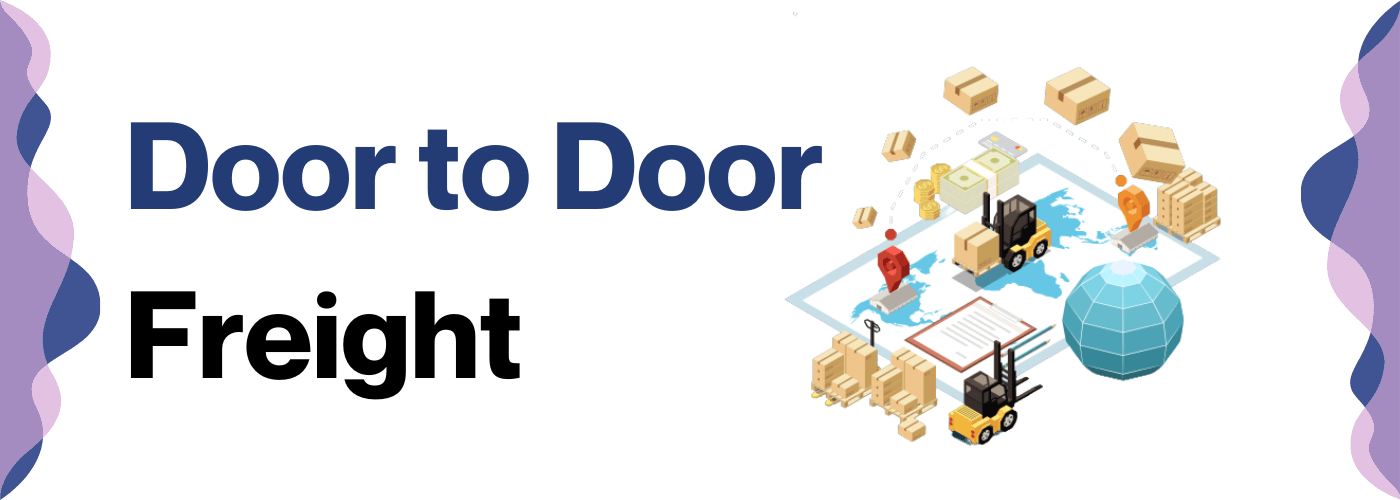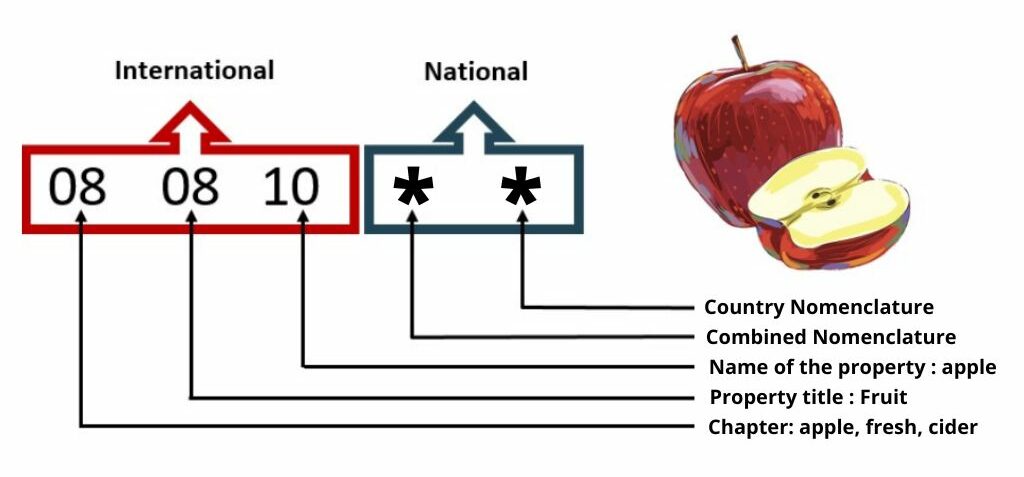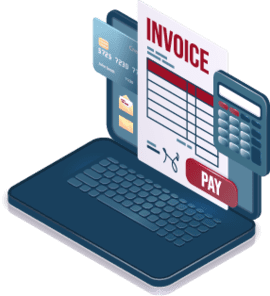Ever tried juggling durians and tabbouleh? That's how coordinating freight from Malaysia to Lebanon can sometimes feel! Unraveling complexities of transit times, rates and customs regulations is not for the faint-hearted. Fortunately, this guide was created to demystify the intricacies of your trading route between these countries, with attention to customs clearance, duties, taxes, and tailored advice that fits your business needs. You'll learn about various freight options, whether it's by air, sea or road, and invaluable insight on making your shipping journey a little less daunting. If the process still feels overwhelming, let DocShipper handle it for you! We're an international freight forwarder committed to transforming your shipping challenges into business triumphs.
Table of Contents
Which are the different modes of transportation between Malaysia and Lebanon?
Deciding on the ideal transport mode from Malaysia's bustling ports to the historic trade routes of Lebanon is like choosing the right vehicle for a family road trip; it depends on your needs! Since rail or road shipping isn't an option owing to geographic barriers, we're left with two main contenders: sea and air transport. Considering factors like cost, delivery speed, and cargo size will help you to determine your winning vehicle. Understanding this conundrum will illuminate your logistics path, streamlining your international trade journey. Here's the rundown on your options!
How can DocShipper help?
Seeking reliable and efficient shipment from Malaysia to Lebanon? DocShipper removes all the logistics headaches providing a seamless process from pickup to delivery. Our expertise extends from managing transport to clearing customs. Reach out for a free estimate in under 24 hours or consult our experts whenever you need. Your global shipping solution is just a call away!
DocShipper Tip: Sea freight might be the best solution for you if:
- You're dealing with hefty quantities or oversized goods. Sea transport is your go-to for maximizing space without stretching your budget.
- Time sensitivity isn't a concern for your shipment. Ocean freight is known for its leisurely pace, especially when compared to the speed of air or rail.
- Your supply chain connects key international harbors. This positions you to take full advantage of a wide-reaching network of ocean trade routes.
Sea freight between Malaysia and Lebanon
In this critical section on maritime trade between Malaysia and Lebanon, we uncover both the opportunities and challenges in sea freight. The bustling Port Klang in Malaysia and Beirut's vibrant port in Lebanon serve as mainstays in the exchange of goods, acting as gateways to robust marketplaces. The call of the sea offers an economical solution for transport of bulky goods - though it asks for patience in the form of longer transit times. However, it's not always smooth sailing, is it? For many, the waters of international shipping can seem murky and unpredictable. Picture steering a boat in a storm without a compass; that's how chaotic it feels for some businesses when shipping between these two nations without knowing the specifics. But don't worry; we're here to help you safely steer through these turbulent waters. We'll throw a lifeline with best practices that can simplify the process and help avoid common, costly mistakes. Now, who's ready to set sail?
Main shipping ports in Malaysia
Location and Volume: Located near the capital city of Kuala Lumpur, Port Klang is the largest maritime gateway to Malaysia. The port handles over 13.2 million TEUs annually.
Key Trading Partners and Strategic Importance: It serves as a significant hub for transshipment links and also trades extensively with China, Singapore, Europe, and the United States. Its strategic location in the Strait of Malacca, one of the world's busiest shipping lanes, further enhances its importance.
Context for Businesses: If you're looking to expand your regional or global footprint, utilizing the facilities of Port Klang could streamline your logistics, given its well-established connections with major international ports.
Location and Volume: Based in the state of Johor, Tanjung Pelepas Port handles around 9 million TEUs annually and is recognized as the fastest growing port in Malaysia.
Key Trading Partners and Strategic Importance: Key trading partners include Singapore, China, Hong Kong, and Taiwan, with notable trade of electronics, petrochemicals, and textiles. It's the preferred port for giants like Maersk and MSC due to its world-class infrastructure.
Context for Businesses: If your business is in electronics or textile industries and you're targeting growth in the Asian region, employing Tanjung Pelepas Port's services could prove beneficial, given its commodities specialization and excellent connectivity.
Location and Volume: A key player in the Northwest region, Penang Port serves as a vital link with a volume of around 1.5 million TEUs annually.
Key Trading Partners and Strategic Importance: With regular services to key maritime hubs like Singapore and Hong Kong, the port also trades with India and China. It further stands as a strategic base for the Northern Corridor Economic Region development project.
Context for Businesses: If your objective is to strengthen your supply chains in North Malaysia or around the Andaman Sea, Penang Port's strategic location and development potential make it a viable option.
Location and Volume: Bintulu Port, located in Sarawak, mainly handles bulk and break-bulk cargo and is the chief export gateway for LNG with a handling capacity of 49 million tons annually.
Key Trading Partners and Strategic Importance: This port primarily trades with Asian countries and is vital for energy shipping. It boasts of being part of the world’s largest LNG production facility at a single location.
Context for Businesses: If your business profile includes oil, gas, or energy commodities eyeing Asian markets, Bintulu Port's heavy focus on these sectors offers a distinct advantage for streamlining your logistics.
Location and Volume: Located on the east coast, Kuantan Port serves as the gateway to the South China Sea and handles around 26 million freight weight tons annually.
Key Trading Partners and Strategic Importance: Principal trading partners include China, Thailand, Singapore, and Japan. The port is a key transshipment point for iron ore, which makes it especially vital for mining industries.
Context for Businesses: If your company is involved with mining or related heavy industries, integrating your logistics strategy with Kuantan Port could provide you with significant operational efficiencies given its specialized services.
Location and Volume: Based in the industrial state of Johor, Johor Port is a multi-purpose port with an annual handling capacity of 40 million freight weight tons.
Key Trading Partners and Strategic Importance: Does substantial trade with countries like Indonesia, India, and Singapore. As one of the largest free trade zones in Malaysia, it holds strategic importance for various industries.
Context for Businesses: If you are looking at trade opportunities within ASEAN countries, the Free Zone benefits provided by Johor Port can present a strong platform for your logistics needs, further facilitated by its comprehensive range of cargo handling services.
Main shipping ports in Lebanon
Location and Volume: The Port of Beirut is crucial to Lebanon's international trade. It's located in the capital city, Beirut, next to the heart of the city's commercial center. The port facilitates the exchange of a wide range of goods, with a shipping volume surpassing 1 million TEUs annually.
Key Trading Partners and Strategic Importance: Major trading partners include other Mediterranean countries, the Middle East, and European countries including Italy, Turkey, and Greece. It’s strategically located as a link between the West and East, serving as a principal import and export gateway for Lebanon.
Context for Businesses: If you are looking to expand your trade network to cover the Mediterranean and Middle Eastern markets, the Port of Beirut is a significant link. Its logistical connectivity, strategic location, and operational versatility can effectively cater to your business needs.
Port of Tripoli
Location and Volume: The Port of Tripoli, located in the northern city of Tripoli, is the second major port in Lebanon. It complements the Port of Beirut with a slightly lower shipping volume, but still contributes a significant amount to Lebanon's total maritime commerce.
Key Trading Partners and Strategic Importance: Its main trading partners are countries in the Mediterranean basin, as well as other nations in Africa and Asia. It's also strategically important to Lebanon’s international trade as it facilitates the flow of agricultural products and materials crucial for the country's manufacturing and industrial sectors.
Context for Businesses: If your business targets the markets of North Africa, Southern Europe, and the Middle East, the Port of Tripoli could be a crucial part of your logistics strategy given its trade flow and proximity to these markets.
Should I choose FCL or LCL when shipping between Malaysia and Lebanon?
Choosing between Full Container Load (FCL) and Less than Container Load (LCL), also known as consolidation, for your sea freight from Malaysia to Lebanon isn't simply a coin toss. Your choice profoundly shapes your shipping journey, touching on costs, delivery schedules, and overall success. It's about fine-tuning logistics to your specific needs. In the following, we'll lay bare the differences, help you weigh the pros and cons, and guide you towards a decision that aligns perfectly with your shipping goals. Get ready to master your sea freight options!
LCL: Less than Container Load
Definition: Less than Container Load (LCL) shipping refers to a method of shipment where your cargo does not fill an entire shipping container. Different shipments share the same container space, which cuts the cost compared to hiring a full container.
When to Use: LCL shipment is the most cost-effective and flexible option for low-volume cargo. It is particularly beneficial when your cargo volume falls under the 13/14/15 CBM limit. This method offers flexibility, as you only pay for the space your cargo occupies in the container.
Example: Let's consider an electronics store in Lebanon ordering 10 CBM of mobile accessories from a Malaysian supplier. As the volume is less than 15 CBM, the store opts for an LCL shipment and only pays for the 10 CBM space rather than a whole container.
Cost Implications: Although it may initially appear more expensive per CBM, LCL freight can often be cheaper when compared to full container shipping. You only pay for the space you use, avoiding the need to fill an entire container. This approach can significantly reduce your shipping costs if you have a lower volume of cargo.
FCL: Full Container Load
Definition: FCL shipping, or Full Container Load, is a mode of transport where an entire container is used for a single shipment. This option uses either a 20'ft container or a 40'ft container, depending on the cargo size.
When to Use: FCL is the preferable choice when the shipment volume exceeds 13/14/15 CBM. It is not only more cost-effective for high volume cargo but also ensures safety as the container remains sealed from origin to destination.
Example: Consider a furniture company wanting to export a large consignment from Malaysia to Lebanon. If the total size exceeds 15 CBM, choosing FCL would result in lower per unit cost and increased safety. The company can acquire an FCL shipping quote and decide accordingly.
Cost implications: While an FCL container generally implies a higher upfront cost due to the larger container size, it ultimately lowers the cost per unit. The financial benefit becomes apparent when shipping larger volumes. Furthermore, if you choose FCL, the chance of customs delays is reduced, resulting in further indirect savings.
Unlock hassle-free shipping
Confused about choosing between consolidation and a full container for your Malaysia-Lebanon shipment? DocShipper, a renowned freight forwarder, is committed to simplifying this decision for you. Our team of ocean freight experts assists in comparing costs, timings, and custom rules, ultimately helping you find the optimal solution. So, whether your priority is budget, speed, or reliability, we've got covered. Ready to simplify your cargo shipping experience? Get in touch for a free estimation. Let's make shipping a breeze together.
How long does sea freight take between Malaysia and Lebanon?
The average transit time for sea freight between Malaysia and Lebanon ranges substantially, subject to fundamental variables like the specific ports used, the weight, and nature of the goods being shipped. Given the complexities associated with these factors, businesses are recommended to contact freight forwarders like DocShipper for a tailored quote based on their unique shipment.
Now, let's consider the average transit times for the main freight ports in both countries:
| Malaysia | Lebanon | Average Transit Time (days) |
| Port Klang | Port of Beirut | 21 |
| Tanjung Pelepas | Port of Beirut | 21 |
| Pasir Gudang | Port of Tripoli | 21 |
| Kuantan Port | Port of Tripoli | 21 |
*Remember, these are only average times and actual transit times may vary. For the most accurate information, please reach out for a specific quote.
How much does it cost to ship a container between Malaysia and Lebanon?
Figuring out the cost to ship a container from Malaysia to Lebanon? It's not as straightforward as you might think. Ocean freight rates and shipping costs vary broadly depending on several factors like the Point of Loading, Point of Destination, the carrier chosen, the nature of your goods, and even the monthly market fluctuations. Given these factors, pinpointing an exact price can be akin to hitting a moving target. But here's what is certain - our shipping specialists are dedicated to getting you the optimal rates for your shipping needs. We consider every detail, examine each case individually, and quote based on your unique scenarios, ensuring you get the best bang for your buck.
Special transportation services
Out of Gauge (OOG) Container
Definition: Out Of Gauge (OOG) containers are specifically designed to hold items that cannot fit within the dimensions of standard containers. These are often larger, oversized items that exceed the dimensions of regular shipping containers.
Suitable for: Companies that need to ship oversized goods like heavy machinery, large equipment, or construction materials will find OOG containers essential.
Examples: Construction equipment, large industrial machine parts, vehicles, and heavy machinery are typically shipped using OOG containers.
Why it might be the best choice for you: If your cargo is too large to fit into standard containers, an OOG container is your go-to option. It eliminates the need to dismantle large equipment, saving you time and money.
Break Bulk
Definition: Break bulk refers to goods that must be loaded individually, not in containers, onto vessels. They are not in any form of container and generally shipped on pallets, in crates, or as individual pieces.
Suitable for: Businesses shipping goods that cannot be containerized due to size, shape, or quantity will find break bulk shipping quite useful.
Examples: Large pipes, wood or metal beams, and oversized vehicles are types of cargo often shipped as break bulk.
Why it might be the best choice for you: If you've got cargo that isn't suited to containerization due to its size, shape or number, break bulk shipping provides a flexible method of sea freight.
Dry Bulk
Definition: Dry bulk refers to goods shipped in large quantities, unpackaged, and in loose form. These cargoes are usually dropped or poured as a liquid or solid into a bulk carrier ship's hold.
Suitable for: This shipping method is ideal for businesses with large quantities of unpackaged goods like coal, grains, or minerals.
Examples: Commodities such as coal, grain, and ore are typically shipped as dry bulk due to their sheer volume and mass.
Why it might be the best choice for you: Dry bulk shipping offers a cost-effective solution if your business involves shipping large volumes of loose cargo load like grains or minerals.
Roll-on/Roll-off (Ro-Ro)
Definition: Roll-on/Roll-off shipping involves goods that can be driven or rolled onto a specialized ro-ro vessel. These vessels are equipped with built-in ramps to allow cargo to be efficiently rolled on and off.
Suitable for: Companies shipping wheeled cargo such as cars, trucks, trailers, or equipment that's driven on and off the vessel will benefit greatly from Ro-Ro shipping.
Examples: Classic cars, new vehicles, buses, trucks, and heavy plant machinery are all perfect candidates for Ro-Ro shipping.
Why it might be the best choice for you: If you're shipping motor vehicles or heavy machinery, the Ro-Ro service offers a safe and cost-effective method to get your items across the sea smoothly.
Reefer Containers
Definition: Reefer containers are refrigerated shipping containers used for transporting goods that require specific temperature controls during transportation.
Suitable for: They're perfect for businesses handling perishable cargo such as seafood, meat, fruits, vegetables, and dairy products.
Examples: Seafood from Malaysia or Lebanons' dairy industry would be shipped in reefer containers to maintain their freshness and quality.
Why it might be the best choice for you: If you're dealing in perishable goods or items that need to maintain a constant temperature, reefer containers provide the perfect environment to keep your goods fresh and undamaged in transit.
We hope this guide clarifies all the available sea freight options between Malaysia and Lebanon. Remember, the choice of shipping method ultimately depends on the type of cargo you have. Ideally, your decision should help you balance between cost, delivery times, and cargo safety.
At DocShipper, we're always ready to offer tailored recommendations based on your business needs. So if you need more details or want a free shipping quote, feel free to contact us. We'll respond in less than 24 hours, helping you navigate the world of logistics with ease.
DocShipper Tip: Air freight might be the best solution for you if:
- You're pressed for time or facing a non-negotiable deadline. Air freight delivers unparalleled speed when it comes to transit times.
- Your shipment is modest in size, falling under 2 CBM. Air freight is particularly well-suited for these smaller consignments.
- Your supply chain includes destinations that are off the beaten maritime or rail paths. Air freight gives you access to a comprehensive global airport network.
Air freight between Malaysia and Lebanon
Consider the air freight route between Malaysia and Lebanon - it's like the express elevator of international shipping, swift and reliable. Particularly for compact, high-value shipments such as delicate electronics or time-sensitive documents, this method is a cost-friendly knight in shining armor.
However, many businesses stumble into a pitfall, tripping up on crucial details in estimating air freight costs. It's like using a faulty calculator - a shipment's weight incorrectly calculated can lead to an unexpected shock at the air freight bill. Many also overlook best practices, akin to skipping chapters in a guidebook, potentially escalating their costs dramatically. Don't worry, we'll journey through these complexities together, ensuring you're well-equipped for your air freight adventure.
Air Cargo vs Express Air Freight: How should I ship?
Life in the fast lane can be pretty exhilarating, and when you're shipping goods from Malaysia to Lebanon, it's no different. Whether it's air cargo, where your goods share some in-flight space with other items on an airline, or express air freight, where your precious cargo zooms across countries in a plane all to themselves - choosing the right sky-high path could profoundly impact your business operations. Let's dig into these two high-flying shipping options, to help propel your business to new heights!
Should I choose Air Cargo between Malaysia and Lebanon?
Considering air cargo between Malaysia and Lebanon can be both cost-effective and reliable. Prominent airlines like Malaysia Airlines and Middle East Airlines play key roles in this market, offering dependable services with fixed schedules. While this may result in longer transit times, it ensures predictable delivery dates. Ideal for cargo between 100/150 kg (220/330 lbs), air cargo might particularly suit your budgetary needs. Remember, indeed, it's not just about cost, reliability counts too.
Should I choose Express Air Freight between Malaysia and Lebanon?
Express air freight, a niche service with dedicated cargo planes free of passengers, shines especially for shipments under 1 CBM or 100/150 kg (220/330 lbs) in weight. With companies like FedEx, UPS, or DHL, your goods could traverse from Malaysia to Lebanon in no time. If your cargo fits these parameters and speed is your top priority, this solution may be ideal for you—though it might come with a slightly higher cost. It's a significant advantage to have urgent or smaller shipments delivered swiftly and hassle-free, don't you agree?
Main international airports in Malaysia
Kuala Lumpur International Airport (KLIA)
Cargo Volume: KLIA handled approximately 726,230 tonnes of cargo in 2019.
Key Trading Partners: Main trading partners include China, USA, Japan, Singapore, and India.
Strategic Importance: As the busiest airport in Malaysia, KLIA offers numerous connections worldwide, especially for the ASEAN region.
Notable Features: KLIA's Advanced Cargo Center includes temperature-controlled facilities, a halal logistics hub, and airside connectivity.
For Your Business: If you're seeking efficient global access and a host of cargo facilities, KLIA may be the most viable choice.
Penang International Airport
Cargo Volume: Handled around 172,000 tonnes of cargo in 2017.
Key Trading Partners: Major trading partners are China, the USA, and Southeast Asian countries.
Strategic Importance: Located on Penang Island, this airport is crucial for northern Malaysia, linking to major cities in Asia.
Notable Features: Equipped with wide-bodies freighter facilities, it also offers 24x7 customs clearance.
For Your Business: Ideal for businesses targeting northern Malaysian areas, offering good cargo infrastructure.
Senai International Airport
Cargo Volume: In 2019, it handled approximately 10,000 metric tonnes of cargo.
Key Trading Partners: Key trading partners include China, Singapore, Indonesia, and Thailand.
Strategic Importance: It is the hub for southern peninsular Malaysia, with excellent connectivity to ASEAN countries.
Notable Features: Includes Free Zone and bonded area services, offering significant versatility for cargo handlers.
For Your Business: A practical choice if your enterprise targets southern Malaysia or needs flexible cargo handling services.
Kuching International Airport
Cargo Volume: Managed around 23,000 tonnes of cargo in 2013.
Key Trading Partners: Notable partners are Singapore, Indonesia, and Brunei.
Strategic Importance: This airport serves the Sarawak region and parts of Borneo, providing meagre international links.
Notable Features: Provides services for the handling, storage, and customs clearance of cargo.
For Your Business: This airport may serve well if your scale of operations involves East Malaysia or Borneo.
Kota Kinabalu International Airport
Cargo Volume: Handled about 2,600 tonnes of cargo in 2013.
Key Trading Partners: Major partners include China, Taiwan, and Indonesia.
Strategic Importance: The airport serves Sabah's state, with some international links to East Asian countries.
Notable Features: Adaquate cargo facilities including customs for efficient cargo operations.
For Your Business: If your operation scope includes regions of East Malaysia or East Asia, this airport is a suitable choice.
Main international airports in Lebanon
Rafic Hariri International Airport
Cargo Volume: With an annual cargo handling capacity of over 180,000 tonnes, Rafic Hariri International Airport is the main air-port of entry for goods into Lebanon.
Key Trading Partners: Major trading partners include countries within the Middle East like United Arab Emirates, Saudi Arabia, and Iraq, as well as European countries such as Germany and France.
Strategic Importance: It's the only operational commercial airport in the country, located just south of the capital, Beirut. Its geographic location is crucial because it connects the Middle East, Europe, and the African continent.
Notable Features: It boasts advanced cargo facilities, including temperature-controlled ones, allowing it to handle a variety of specialty goods including perishables and pharmaceuticals.
For Your Business: The airport's comprehensive logistics services could simplify your shipping processes. With express custom clearance and cargo handling available, Rafic Hariri International Airport is well-equipped to help businesses get their goods to the Middle Eastern and European markets efficiently.
How long does air freight take between Malaysia and Lebanon?
On average, air shipping between Malaysia and Lebanon can take between 3 to 6 days. However, these transit times aren't set in stone - they often fluctuate depending on the exact airports involved, the type and weight of the goods being shipped, among other factors. To ensure you have accurate timing information tailored to your goods and requirements, we highly recommend you contact a competent freight forwarder like DocShipper.
How much does it cost to ship a parcel between Malaysia and Lebanon with air freight?
Shipping costs from Malaysia to Lebanon through air freight generally range between $3 and $10 per kilogram. However, providing a precise cost isn't straightforward due to many factors involved, such as the exact pick-up and delivery locations, package dimensions, weight, and nature of goods. Rest assured, our team specializes in creating tailored quotes, promising you the best rates for each unique shipment. Whatever your requirements, we look into every detail while quoting to save you unnecessary costs. Get in touch with us for a free quote within the next 24 hours!
What is the difference between volumetric and gross weight?
Gross weight refers to the actual weight of your shipment, as in how much it physically weighs on a scale. On the other hand, volumetric weight takes into account the space your shipment occupies in relation to its weight. It's essentially the 'weight of the space' your goods take up.
For air cargo, the calculation involves multiplying your shipment's length, width, and height (all in cm), then dividing by 6,000 to get the volumetric weight in kg. For example, a shipment with dimensions 100cm x 50cm x 50cm, amounts to a volumetric weight of 41.67 kg (roughly 92 lbs).
Gross weight, on the other hand, is straightforward. You simply weigh your shipment. Let's say your aforementioned shipment weighs 30kg (approximately 66 lbs).
Now, for express air freight services, the calculation differs slightly. Here, you divide the product of your shipment's dimensions by 5,000. Using our previous dimensions, the volumetric weight would equal 50 kg (about 110 lbs).
Why does this matter? Freight charges depend on these calculations. Generally, carriers charge based on the higher of the two weights - gross or volumetric. This is why it's crucial to consider both these factors when planning your shipments from Malaysia to Lebanon.
DocShipper tip: Door to Door might be the best solution for you if:
- You value convenience and want a seamless shipping process, as door-to-door takes care of every step from pickup to delivery.
- You prefer a single point of contact, as door-to-door services typically provide a dedicated agent to handle all aspects of the shipment.
- You want to minimize the handling of your goods, reducing the risk of damage or loss, as door-to-door minimizes transitions between different modes of transport.
Door to door between Malaysia and Lebanon
Door to Door shipping is a hassle-free approach where your goods are picked up from a location in Malaysia and delivered straight to your doorstep in Lebanon. This strategy offers conveniences like ease of coordination and time savings - crucial luxuries in international shipping. Ready to make global trade a breeze? Let's dive in.
Overview – Door to Door
Efficiently moving goods between Malaysia and Lebanon can feel daunting due to complex customs procedures and multiple transport networks. Door-to-door shipping swiftly lifts these burdens, offering a hassle-free logistics solution. This comprehensive service covers pickup, transportation, customs clearance, and delivery, ensuring you stay focused on your core business. While a tad more expensive, it's a small price for the convenience and peace of mind you get, making it a hot pick among DocShipper's clientele. It's important, however, to understand that delivery times can vary, dependent on the laws and regulations at both ends. Look no further for a simplified, stress-free shipping solution!
Why should I use a Door to Door service between Malaysia and Lebanon?
Who wouldn't want a fairy godmother handling all their shipping woes from Malaysia to Lebanon, right? That, in essence, is the magic of Door-to-Door service. Here are five compelling reasons why you might choose this service:
1. Alleviates Stress: Just like having a personal assistant, this service tackles all the taxing logistics, leaving you free to focus on growing your business. You won't even have to worry about the minutiae of transporting goods; we've got your back!
2. Timely Delivery: Slow and steady might win the race, but in business, speed is king! A Door-to-Door service ensures that your shipments reach their destination on time – no delays, no spoilers, only happy customers.
3. Specialized Care for Complex Cargo: Have goods that require some TLC during transit? Worry not! With Door-to-Door service, your cargo receives special attention, ensuring your goods' safe and secure journey from 'A' to 'B'.
4. Convenience: As the name implies, this service takes responsibility for your goods from your doorstep to your customer's doorstep in Lebanon. No more fretting over on-route handling or coordinating with different logistics partners.
5. Complete Tracking: No need for a crystal ball to keep an eye on your cargo in transit. With Door-to-Door service, enjoy complete tracking so you always know where your cargo is and when it will arrive. You're practically omnipresent!
In a nutshell, these combination of benefits not only eases the shipping process but also provides peace of mind. Door-to-door shipping: it's like having your personal cargo genie!
DocShipper – Door to Door specialist between Malaysia and Lebanon
Discover ease with DocShipper's door-to-door shipping services from Malaysia to Lebanon. Our trained experts handle everything from packing to customs, allowing you to relax while we manage your shipping needs across all transport methods. Benefit from the comfort of a dedicated Account Executive, always available to guide you throughout the process. Reach out to us for a free estimate within 24 hours or consult our experts at no charge. Experience stress-free shipping with DocShipper - your reliable partner in international logistics.
Customs clearance in Lebanon for goods imported from Malaysia
Customs clearance is the critical step to import goods from Malaysia to Lebanon, often riddled with complexities. The process involves intricate details like duties, taxes, quotas, and licenses, all intertwined in a web that could potentially escalate costs if not understood properly. Missteps could result in your goods being held up at the border, causing delays and additional expenses. Don't fret - our guide delves deeper into avoiding these common pitfalls and ensuring a smooth shipping journey. Remember, at DocShipper, we're equipped to handle everything, from A to Z, for all types of goods worldwide. To get an estimate for your project, just provide the origin, value, and HS code of your goods. We're ready when you are!
How to calculate duties & taxes when importing from Malaysia to Lebanon?
Getting a handle on how to calculate duties and taxes on your imports from Malaysia to Lebanon requires a thorough understanding of several key factors. The finicky nature of these estimations call for an intimate understanding, starting from the country of origin, moving on to the HS code, the customs value of the product, and applying the appropriate tariff rate. Additionally, there could be other taxes and fees that may apply to these products. Diving deeper into the dust and specifics, the very first step in this seemingly complex process is pinpointing the exact country where the goods under consideration originated or were produced. This forms the bedrock of how the rest of the process pans out, and can significantly influence the overall costs.
Step 1 - Identify the Country of Origin
Identifying your product's originating country - in this case, Malaysia - is the first and undeniable step in your trade journey.
First, it lays the groundwork for classifying your goods accurately through Harmonized System (HS) codes, directly impacting your payable duties.
Secondly, trading relationships matter. Malaysia and Lebanon enjoy particular trade agreements. Being unaware of these can mean missing out on potential duty reductions.
Third, country of origin plays a pivotal role in customs clearance. Misrepresentation can lead to delays, penalties, or even seizure of goods.
Fourth, value-based ad valorem taxes may apply differently for certain goods, depending on the country of origin.
Lastly, there might be specific import restrictions from Malaysia to Lebanon which we need to consider.
So, keep your documents handy, particularly ones proving your goods' Malaysian origin, be it the Product Origin Certificate or a declaration from the manufacturer.
Remember, this step, though evident, is the linchpin holding your entire shipping operation together - don’t overlook it!
Step 2 - Find the HS Code of your product
The Harmonized System (HS) Code is an international standard for classifying traded products. It's a six-digit code used by customs officials worldwide to determine the duties, taxes, and regulations that apply to a specific product. The HS code is key when it comes to exporting and importing goods because it impacts the cost of shipping, customs clearance times, and ultimately the profitability of your international operations.
If you already have a supplier, the most straightforward way to identify your HS code is to simply ask them. They will be well-acquainted with the products they're dealing with and the associated regulations, including the correct HS Codes.
However, if this information isn't readily available from your supplier, there's a simple process you can follow to find it.
Our first step is to utilize an HS Lookup tool. For this guide, we'll be using the Harmonized Tariff Schedule tool.
Once on the page, simply plug your product's name into the search bar. The result will show you a column labeled 'Heading/Subheading' - this houses your HS code.
Note: Accuracy is of utmost importance when determining the HS Code. An error in this code can lead to delays in shipping, unwelcome surprises in tax or duty payments, and in some cases, potential fines. Always double-check your code and make sure it perfectly matches the given description of your goods.
Now that you've found your HS code, you might wonder how to decipher it. Each digit or group of digits represents very specific information about your product. Here's an infographic showing you how to read an HS code.
Step 3 - Calculate the Customs Value
Putting a figure on your goods for customs purposes may seem straightforward, but it's not just about the invoice price. The figure you need is called the 'Customs Value', and it represents more than the basic value of your goods. It’s actually the CIF (Cost, Insurance, and Freight) value that counts here. CIF is the sum of the goods' price, the cost of international shipping, and the insurance cost. For instance, if you have goods valued at $5000, a shipping fee of $900, and an insurance cost of $100, then the total CIF value is $6000, which will be used as your Customs Value. By using this method, you’ll minimise surprises and be well-prepared for customs procedures in Lebanon.
Step 4 - Figure out the applicable Import Tariff
An import tariff can essentially be described as a tax imposed on goods imported from another country. Let's delve specifically into the tariff system in Lebanon. To identify the applicable tariff, you'd typically break this down into few steps:
First, find the right Harmonized System(HS) Code of your product- this is a standardized system of names and numbers to classify traded products. Suppose your product is a bicycle. Its HS code would be 8712.
Next, you'll need to explore the tariff information for this HS code; you may do that by using specific tariff databases or contacting the customs authority.
Once you've found the tariff rate - let's say it's 10% for simplicity - this is then applied to the product's Cost, Insurance and Freight (CIF) value. Assume the CIF is $500 for our bicycle. You'd calculate import duties like so: $500 (CIF) x 10% (tariff rate) = $50 (import duty).
Remember that the specifics might vary, possibly including additional taxes or variations in rates. Therefore, it's always best to contact a local customs broker or official authorities to confirm. Think of this as a pathway to navigate your goods from Malaysia to Lebanon more seamlessly.
Step 5 - Consider other Import Duties and Taxes
Beyond the basic tariff rate, you could face additional import duties when shipping your goods from Malaysia to Lebanon. These charges can sway depending on both, the country of origin and the product's nature.
For instance, excise duty is another type of taxation applicable to specific goods. These are typically luxury or harmful items, like alcohol or tobacco. Suppose the imported product from Malaysia is champagne. The hypothetical excise duty may be around 20% of the product’s value.
Anti-dumping taxes also could play a part. These are imposed when products are exported at a lower price than their normal value, which could harm the local industry. For example, if you are importing low-priced steel materials from Malaysia that may harm Lebanon’s local steel industry, an anti-dumping tax might be enforced.
Last but certainly not least, is the Value Added Tax (VAT). In Lebanon, the standard VAT rate is 11%. For example, let's say your shipment is valued at $10,000; you would expect to pay roughly $1,100 in VAT upon entry into Lebanon.
Remember, these are merely hypothetical figures and the exact rates can be variable. It's crucial to factor in these charges when calculating your import costs for a smooth and hassle-free shipping experience.
Step 6 - Calculate the Customs Duties
Determining customs duties for goods shipped from Malaysia to Lebanon is a critical step in your shipping process. The calculation involves three principal components: Customs Value, VAT, and potential Anti-dumping Taxes and Excise Duty.
For the first example, let's say you're shipping electronics valued at $10,000 and the customs duty rate is 5%. The customs duty would be $500 ($10,000 × 5%). There's no V.A.T for this scenario.
Secondly, imagine you're shipping furniture worth $20,000. Lebanese customs impose a 10% duty and a 10% VAT. Initially, you'll owe $2,000 in duties ($20,000 × 10%). Next, the VAT gets computed from the sum of the import value and customs duties—in this case, $22,000. Hence, you'll owe $2,200 in VAT ($22,000 × 10%).
Lastly, assume you're shipping cars valued at $30,000, attracting a 20% customs duty, a 20% VAT, and a 10% anti-dumping tax and excise duty. You'll pay $6000 ($30,000 × 20%) in customs, $7,200 ($36,000 × 20%) in VAT, and $3,000 ($30,000 × 10%) in anti-dumping taxes and excise duty.
Figuring out these charges can be complex, however, with DocShipper, you no longer have to worry. Our team can manage every step of your customs clearance, ensuring you never pay more than you should. Contact us and get a free quote in less than 24 hours!
Does DocShipper charge customs fees?
As a Customs Broker, DocShipper only charges for the customs clearance service in Malaysia and Lebanon. Don't confuse these fees with the separate customs duties and taxes that you pay directly to the government. To maintain transparency, we supply necessary customs office documents as proof that you're only charged the exact government fees, ensuring no unwelcome surprises. It's like dining out; while you pay for the meal (duties and taxes), the service charge (customs clearance fee) is separate!
Contact Details for Customs Authorities
Malaysia Customs
Official name: Royal Malaysian Customs Department
Official website: https://www.customs.gov.my
Lebanon Customs
Official name: Lebanese Customs Administration
Official website: http://www.customs.gov.lb/
Required documents for customs clearance
Step into the world of customs clearance. It can be a maze of paperwork: your Bill of Lading, Packing List, Certificate of Origin, and compliance documents like the CE standard. Getting them wrong could mean delays, fines, or getting your shipment stuck. Let's unravel these complexities together. Here's the key to controlling your shipping destiny!
Bill of Lading
Shipping goods between Malaysia and Lebanon can seem like a daunting task, but with the Bill of Lading, it becomes a cinch. This official document is your baton in the shipping relay, transferring goods ownership and providing a concrete receipt. It's like your passport, verifying what’s dispatched and received. For speedy logistics, consider the electronic ('telex') release. It smoothes the process by eliminating paper documents and speeding up deliveries—no more waiting for the mail! For air cargo, the Air Waybill (AWB) serves a similar purpose as the Bill of Lading. Remember, shipping isn't about guesswork, it's knowing the rules of the game. Keep these critical documents close and make your Malaysia to Lebanon freight work like a well-oiled machine.
Packing List
A Packing List is like your shipment's ID card—it proves its legitimacy at major checkpoints, whether you’re shipping by sea or air from Malaysia to Lebanon. It’s an essential detail-oriented document you, as the shipper, are responsible for. Every tiny item in your shipment needs to be recorded on the Packing List, showing the item description, quantity, weight, and packaging type. Don't gloss over the details—if you're shipping 500 units of electronic parts, we mean every last screw and chip has to be accounted for. Its accuracy is non-negotiable, as customs officials use it to validate the shipment's contents. For example, imagine your shipment being held up because inaccurate packing list causes confusion for Lebanese customs. Such delays can be costly! Bottom line? An accurate Packing List ensures a smooth, hitch-free customs clearance process, keeping your freight on schedule.
Commercial Invoice
Your Commercial Invoice is your passport for your goods as they navigate from Malaysia to Lebanon. It's a must-have document stating the true value of the goods you're shipping and contains essential details, such as a complete description of goods, unit prices, and the terms of sale.
Complete alignment between your Commercial Invoice and other shipping documents eases customs clearance. For example, if you’re shipping Bluetooth devices, the commercial invoice should match the description on the Bill of Lading. The slightest mismatch can lead to unnecessary customs hold-up.
Bonus tip: to avoid any delay, double-check your invoice details. A simple oversight, like a missing Harmonized System (HS) Code, can cause significant setbacks. It's these minute details that will streamline your expedition. So, don’t overlook them.
Certificate of Origin
If you're shipping goods from Malaysia to Lebanon, a Certificate of Origin (CO) is an essential document. The CO shows where your merchandise was manufactured - it's like your product's passport. This document can unlock potential benefits like preferential customs duty rates. For instance, a business shipping electronics parts manufactured in Kuala Lumpur could see significant duty savings. But remember, not specifying your production origin can make the customs process more expensive and slower, so always include it. Ensuring your CO is accurate and complete not only makes your shipment's journey smoother but also brings valuable cost savings.
Get Started with DocShipper
Overwhelmed by customs clearance steps between Malaysia and Lebanon? DocShipper is your one-stop solution. We manage every detail, eliminating stress and streamlining your shipping process. Why not leave the complexity to us? Request a free quote today and receive it in less than 24 hours. Let's simplify your global shipping operations together.
Prohibited and Restricted items when importing into Lebanon
Shipping freight to Lebanon? Beware! Each country has unique prohibitions and restrictions. These can cause headaches if you're caught unprepared. Our guide will unravel the complexities, helping you avoid hefty fines and shipment delays. Stay tuned.
Restricted Products
- Live Animals: You need to apply for an Import Permit from the Ministry of Agriculture in Lebanon.
- Firearms and Ammunition: You're required to obtain a special license from the Ministry of Interior and Municipalities. Check out their website.
- Narcotics: You must secure a Narcotics Permit from the Ministry of Public Health. Their homepage has additional details.
- Radioactive Material: You need to get in touch with the Lebanese Atomic Energy Commission for a permit. Visit their website.
- Cultural Artifacts and Precious Metals: The Ministry of Culture can provide you with the required permit. Their official site is where you can find more information.
- Pharmaceutical Products: The Ministry of Public Health can guide you with the applicable permit.
- Certain Agricultural Products: An Import Permit from the Ministry of Agriculture is necessary.
- Toxic and Hazardous Wastes: You're required to secure a permit from the Ministry of Environment. Check out their homepage.
Remember, it's critical to double-check your specific requirements as regulations change frequently and the list doesn't cover all restrictions. Ensure you're always following the most up-to-date guidelines!
Prohibited products
- Narcotic drugs and psychotropic substances
- Hazardous chemical and biological substances, except under special permits
- Counterfeit money and goods
- Pornographic materials
- Explosives and pyrotechnical products, except under special licenses
- Indigenous and exotic animals, alive or dead, and their products
- Items that infringe intellectual property rights
- Gaming machines, such as slot machines
- Radioactive materials, except under special permits
- Weapons and ammunition, except under special permits
- Plants and plant products, except under special permits
- Certain medical substances and complementary medicinal products
- Cultural artifacts and antiques, unless provenance can be proven
- Certain food products, specifically those not meeting Lebanon’s health regulations
- Telecommunication equipment not approved by relevant authorities
Are there any trade agreements between Malaysia and Lebanon
While there's no current Free Trade Agreement (FTA) or Economic Partnership Agreement (EPA) between Malaysia and Lebanon, the two nations enjoy a cordial trading relationship. Currently, both countries are exploring avenues of mutual interest, like digital trade and clean energy initiatives, which could impact your business positively in the future. It's also worth noting that Lebanon is part of the Great Arab Free Trade Area (GAFTA), which Malaysia is seeking to engage. Keep an eye on these movements as they might present new opportunities for your business.
Malaysia - Lebanon trade and economic relationship
Malaysia and Lebanon share a rich history of trade, with ties stretching back to the 1860s. In recent years, they've strengthened economic relations, achieving significant milestones such as the Bilateral Investment Treaty in 1998. The key sectors between both economies revolve around processed food, construction, and textiles, with major commodities comprising electrical and electronic products, palm oil, and natural rubber. Lebanon invests mostly in Malaysia's service sector, while Malaysia primarily involves in Lebanon's manufacturing industry. As per recent data, total trade between both countries witnessed a significant growth of 84.3% in 2023, valued at RM 1463.94 Million. This mutual growth highlights the dynamic, proactive relationship between Malaysia and Lebanon, boosting opportunities for your business in these flourishing markets.
Your Next Step with DocShipper
Shipping between Malaysia and Lebanon can be complex and time-consuming. Go past the challenges of customs clearance, document procedures, or choice of transport mode with DocShipper. We specialize in streamlining the process for you. Experience seamless and efficient shipping. Contact us today, let's handle your shipping challenges!
Additional logistics services
Discover how DocShipper goes beyond the basics, streamlining your entire supply chain process. From warehousing to packaging and insurance, we’re your all-encompassing logistics partner. Let’s revolutionize your cargo journey together!
Warehousing and storage
Discovering reliable warehousing can be a hassle. Especially when you're shipping temperature-sensitive goods like food or pharmaceuticals between Malaysia and Lebanon. You need a place that ensures optimal conditions to maintain the quality of your products. Ditch the stress and let us handle it. Explore more about our tailor-made warehousing solutions at Warehousing that's built to cater to your specialty needs.
Packaging and repackaging
Safeguard your goods from Malaysia to Lebanon with uncompromised packaging and repackaging services. Trust in an efficient partner is crucial due to intricate product variety - think delicate electronics requiring cushioning or heavy equipment demanding rugged crates. Done well, this step can prevent costly product damage during shipment. More info on our dedicated page: Freight packaging.
Cargo insurance
When shipping goods, unpredicted events can occur. Transport insurance, unlike fire insurance, goes beyond covering damage from flames; it safeguards against various risks during transportation. Picture your items, caught in a storm at sea, suffering water damage. With our Cargo Insurance, you're protected! Massive difference, right? Less of a gamble, more peace of mind. Dive deeper into how we got you covered over at our Cargo Insurance.
Supplier Management (Sourcing)
Overwhelmed by the complexities of sourcing and manufacturing in Asia or East Europe? DocShipper has got you covered! We expertly find reliable suppliers and streamline your procurement process, effortlessly bridging language gaps along the way. Picture this: no language barriers, no logistical headaches—just smooth, end-to-end supplier management. Learn more on our dedicated page Sourcing services.
Personal effects shipping
Moving precious, fragile, or bulky items from Malaysia to Lebanon? Rest assured, our expert team meticulously handles your personal effects with top-notch professionalism and ultimate flexibility. Think, safely transporting your grandma's antique ceramic vase or your oversized home entertainment system, sans stress. Want to learn more? Dive right into our dedicated page: Shipping Personal Belongs for detailed insights.
Quality Control
Quality inspections play a pivotal role in shipping from Malaysia to Lebanon. They ensure that your goods adhere to both countries' standards before they hit the road. Think of it like a pre-shipment check-up; it's that extra step that can save a recall nightmare. Consider the clothing industry - one faulty batch can harm your reputation and revenue. Allow us to shoulder this burden, with our meticulous quality control service. Find out more on our Quality Inspection page.
Product compliance services
Shipping products across borders? Adherence to foreign regulations is crucial. Our top-notch product compliance services got you covered. Using advanced laboratory testing, we ensure your products meet destination-specific rules - preventing costly hassles and fostering trust with your customers. Step into the future with confidence. More info on our dedicated page: Product compliance services.
FAQ | For 1st-time importers between Malaysia and Lebanon
What is the necessary paperwork during shipping between Malaysia and Lebanon?
Shipping from Malaysia to Lebanon does require specific paperwork. Firstly, we, at DocShipper, issue the mandatory Bill of Lading for sea freight or Air Waybill for air freight. Your part is to provide us with a packing list and a commercial invoice at a minimum. Note that other documents could be necessary depending on the nature of your goods. For example, a Material Safety Data Sheet (MSDS) may be required for hazardous materials, or certain items may need specific certifications. Remember, we're here to guide you through this process, ensuring you successfully comply with all import regulations while keeping your shipment on schedule.
Do I need a customs broker while importing in Lebanon?
Indeed, hiring a customs broker for imports in Lebanon is highly advisable due to the complexity of the customs processes and the requisite handling of numerous documents and details. At DocShipper, we provide support in the overwhelming majority of shipments, representing your cargo at customs, navigating bureaucratic procedures, and ensuring you don't miss any necessary steps. This takes away some of the stress of international shipping, enabling you to focus on other aspects of your business. Our goal is to streamline your freight forwarding experience through expert navigation of the customs clearance process.
Can air freight be cheaper than sea freight between Malaysia and Lebanon?
We appreciate that business owners want straightforward answers. However, when comparing air and sea freight costs, various factors come into play, including route, weight, and volume. Typically, if your cargo is less than 1.5 Cubic Meters or weighs under 300 kg (660 lbs), air freight may indeed cost less. But, we at DocShipper understand the intricacies of freight forwarding and commit to providing the most competitive option. Your dedicated account executive will closely examine your specific needs and guide you towards the most cost-effective and efficient shipping method.
What is the cheapest way to ship to Lebanon from Malaysia?
Given the considerable distance between Malaysia and Lebanon, the most cost-effective shipping method would typically be sea freight. However, it's essential to understand that while this may be cheaper, it takes longer than air freight. Bear in mind, the exact cost will depend on the kind of commodity being shipped, its size, weight, and other specific requirements. We at DocShipper can provide both options and customize a solution to suit your specific needs and budget.
EXW, FOB, or CIF?
Choosing between EXW (Ex Works), FOB (Free On Board), or CIF (Cost Insurance and Freight) largely depends on your relationship with your supplier. Often, suppliers sell under EXW or FOB terms, covering everything from their factory door to the origin terminal. However, keep in mind that your supplier may not be well-versed in logistics. Therefore, it's recommended to engage a logistics agent like us at DocShipper. We can take care of the international freight and destination processes, providing a comprehensive door to door service. This way, you can avoid potential complications and ensure your goods are handled professionally and efficiently.
Goods have arrived at my port in Lebanon, how do I get them delivered to the final destination?
Upon the arrival of your goods at the Lebanese port, if they are covered under the CIF/CFR incoterms, you will require the services of a customs broker or freight forwarder to assist with terminal clearance, import charges, and final delivery. Alternatively, we at DocShipper can manage the process in its entirety via DAP incoterms. Please consult with your dedicated account executive to discuss these terms further. This ensures smooth delivery to your desired location.
Does your quotation include all cost?
Absolutely, we aim to make our pricing process transparent. Our quotation includes all costs apart from duties and taxes at your destination. However, your dedicated account executive is always ready to make an estimate for these for you. We are committed to ensuring there are no hidden fees for a smooth shipping experience.
